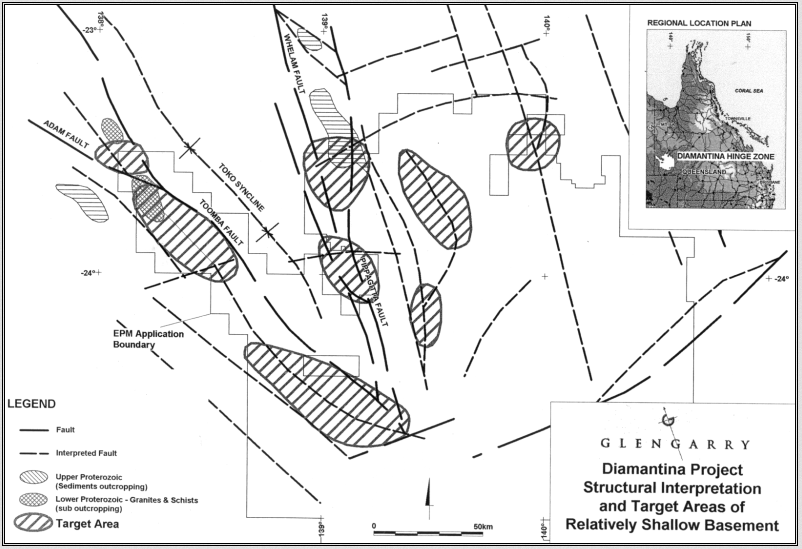
Tony Alston, Exploration Director, Glengarry Resources NL
Click here to download paper as PDF
Glengarry Resources NL has applied for some 42,000 sq km of ground centred on the town of Bedourie, located about 350 km south of Mt Isa in western Queensland. The Project has been named the Diamantina Hinge Zone because of the interpreted intersection of two major intracontinental structures, i.e. the ESE trending Tran Tanami/Arunta Structure and the NE trending Diamantina Orogen. This hinge zone terminates the southern end of the Proterozoic Mt Isa Block and is considered to be very prospective for the discovery of major polymetallic deposits.
The main targets for Glengarry are concealed Proterozoic granite breccia copper/gold deposits such as Roxby Downs and Ernest Henry, as well as sediment hosted lead, zinc, silver deposits such as Mt Isa and Cannington. In addition, vanadium and Kupperscheiffer style platinum/palladium mineralisation will be searched for in pyritic black shales associated with the younger Toolebuc Limestone that occurs at shallow depth over much of the application ground.
The reason little exploration has been carried out in the past over the southern third of the Mt Isa Block that hosts a number of world class basemetal mines, has been the perception of deep cover, combined with lack of quality aeromagnetic data and suitable geochemical techniques to “see through” the cover.
Research by Glengarry, in collaboration with Fractal Graphics, on the AGSO gravity and magnetic data sets (combined with some more recent high resolution magnetic surveys, seismic data and drilling information from government water bores and company holes) indicates that there are significant areas where shallow basement is likely. Areas such as the Toomba Fault Zone and the Mt Whelan Fault Zone appear to have excellent potential for mineralisation, because of relatively shallow basement (10 to 350 m) in zones of dramatic block uplift that are close to co-incident regional magnetic and gravity anomalies, and where alteration has been observed from some previous drilling (Figures 1 and 2).
Recent advances in partial extraction geochemical soil sampling techniques, applicable to areas of cover in arid environments, further enhances discovery possibilities as these techniques have not previously been trialed in the Diamantina region. Similarly, although there are widespread water bores in the district, no multi-element sampling of the water appears to have been undertaken by modern methods.
In summary Glengarry is confident that polymetallic drill targets can be outlined cost effectively using structural and depth to basement interpretation integrated with more recent geochemical information, thus advancing the mineralisation credentials of the Diamantina Hinge Zone in a relatively short time frame.


Received: March 2000
Published: May 2000
AIG Journal Paper 2000-07, May 2000
